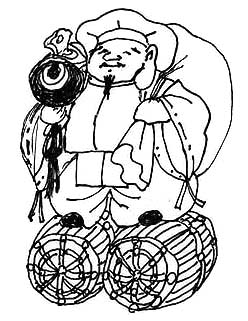|
||
 |
||
@

@
(C)2001 Japanese Architecture and Art Net Users System.@No reproduction or republication without written permission.
fΪΜeLXgEΚ^ECXgΘΗASΔΜRecΜ³f‘»E]ΪπΦΆά·B
|
||||||
| @ | ||||||
| Daikokuten@εV | ||||||
| KEY WORD :@art history / iconography | ||||||
| @ | ||||||
| Daikokuten is generally famous as a god of luck. He is most familiar in Japan as a fat, smiling figure with a big sack over his left shoulder and a mallet in his right hand, standing on bales tawara U full of rice. He was particularly popular in the Edo period, as one of the seven gods of good fortune *shichifukujin ΅_. However, in India he was a warrior deity called Mahakala and was considered an emanation of Siva. In texts his name was transliterated as Makakara ζdή and translated as Daikokuten in the DAIHOUDOUDAIJIKKYOU εϋεWo, translated in the Sui dynasty. In Japan he appears in the outer court of the *Taizoukai mandara Ω EΦδΆ ; Gekongoubu-in Oΰ@ as a three faced, six-armed seated deity. According to the DAINICHIKYOUSHOU εϊo`, *Dainichi εϊ appear as Daikokuten in order to subdue Dakiniten δΆgςV. However, there are no independent images of Daikokuten in Japan that resemble the one in the Taizoukai mandara. It appears that Daikokuten came to be a protector of food supply because images of him were placed in monastery kitchens in India and in China. In Japan this practice is said to have been begun by Saichou Ε (767-822) on Mt. Hiei δb. The oldest extant image of Daikokuten in Japan is the late Heian wooden sculpture in Kanzeonji Ο’Ή in Fukuoka prefecture. In this, his expression is fierce. In the sculpture of Myoujuin Ύυ@ of Kongourinji ΰΦ (Shiga prefecture; late Heian period) he is shown in armor. Thus, his identity as a war god is still apparent. Later he became more closely associated with food and good fortune. This tendency was reinforced by his identification with the Shinto deity Ookuninushi no Mikoto εε½. The sculpture of Saidaiji Όε in Nara (13c), which still displays a severe countenance and does not include the tawara was made by Zenshun Pt on the order of Eison bΈ (1201-90) after he had a vision of Makakara. Of the many later sculptures, those of Shoujuraigouji ΉO} (1339) in Shiga prefecture by Suruga Ajari xΝ’θ; of Hokkeji @Ψ (1319) in Nara; and that of Kojimadera q(1609) in Nara; are among those that are notable. | ||||||
| @ @ |
||||||
 |
||||||
@ |
||||||
| REFERENCES: | ||||||
| @ | ||||||
| EXTERNAL LINKS: | ||||||
| @@ | ||||||
| NOTES: | ||||||
| @ | ||||||
(C)2001 Japanese Architecture and Art Net Users System.@No reproduction or republication without written permission. fΪΜeLXgEΚ^ECXgΘΗASΔΜRecΜ³f‘»E]ΪπΦΆά·B |
||||||
| @ |